|

by
Steve Troy
2002
from
MoonAnomalies Website
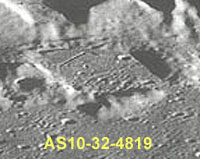 Early in
Richard
Hoagland’s lunar investigation, he discovered a ‘geometrically
square shape’ on Apollo 10 frame 4819
located very near Ukert crater in Sinus Medii.
From his years of grappling with the Cydonia geometry
trying to sift the signals from the noise of Martian
mesas and dunes, this rectilinear arrangement of hills and
parallel lines was a definitive anomalous lunar signal. Early in
Richard
Hoagland’s lunar investigation, he discovered a ‘geometrically
square shape’ on Apollo 10 frame 4819
located very near Ukert crater in Sinus Medii.
From his years of grappling with the Cydonia geometry
trying to sift the signals from the noise of Martian
mesas and dunes, this rectilinear arrangement of hills and
parallel lines was a definitive anomalous lunar signal.
It would
eventually lead him to a plethora of remarkable discoveries in
this region --- discoveries that have changed the way we see the
Moon today.
Background on Central Bay
With the exception of this square signal, frame AS10-32-4819 seemed to
be a rather average 70mm Hasselblad photograph. It
wasn’t until he examined more of the AS10-4800 series that he
realized that there were more revealing and profound discoveries to
come. Looking at the Apollo 10 Photographic Catalog (NASA
SP-232), one can see that several oblique 80mm Hasselblad
photographs were taken of this particular area from similar altitude
as the spacecraft passed from west to east over Central Bay. Each shows a unique view of the features
there.
The Apollo 10 ‘4800 series’ of photos became a target of
Hoagland’s investigation. When he went up a few frame numbers in the
Apollo 10 catalog and discovered what was actually on darkened blank
frame #4822 on page 197, things on the lunar front began to get
interesting. This included the astonishing realization that after he
ordered that particular negative, there indeed was a brilliantly
resolved image where there wasn’t supposed to be one at all.
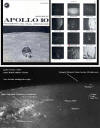 During the
mid-1990s, he discovered that there was more than one version of
this frame, and as a result, his investigation of Central Bay
intensified. During the
mid-1990s, he discovered that there was more than one version of
this frame, and as a result, his investigation of Central Bay
intensified.
To date, there have
been 12 different unique versions of this frame found, each
taken at different times, and like a fingerprint, each showing
subtle progressive changes from frame to frame.
Each of them shows
extraordinary
lunar
arcologies, artifacts and anomalous geometry.
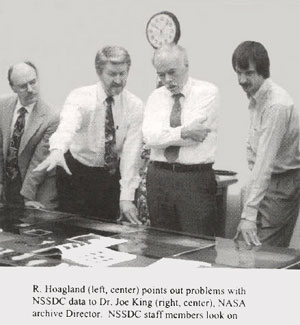 During Hoagland’s
subsequent visit to the NSSDC in Greenbelt, MD, he
not only asked archive director Dr. Joe King why there
was more than one version of 4822 when only one single frame was
listed as existing (a deliberate misrepresentation), but he also
presented assembled specific evidence supporting lunar artifacts
for this and other frames. During Hoagland’s
subsequent visit to the NSSDC in Greenbelt, MD, he
not only asked archive director Dr. Joe King why there
was more than one version of 4822 when only one single frame was
listed as existing (a deliberate misrepresentation), but he also
presented assembled specific evidence supporting lunar artifacts
for this and other frames.
NSSDC
pledged at that time that the continuing investigation would
have access to the best possible data.
From my later entry into this investigation, the history of this
pledge made by NSSDC in the mid ‘90’s to the
present has revealed that their data has definitely improved,
but that it also has a way to go.
Discrepancies, for example, still remain concerning the recording of
scale and location in photographic catalogs, differing statistics in
NASA publications on lunar nomenclature, as well as
conspicuously absent or difficult to interpret frame numbers Apollo
mission photo maps. Through some real digging however, many of the
unlisted photograph locations have been found through our lunar
work, and not surprisingly, negatives accessed from NSSDC
of these ambiguously listed locations have revealed stunning
evidence of artificiality.
The Central Bay 4800 frames from Apollo 10 have become
and continue to be a ‘launch-region’ for this facet of lunar
investigative science. When entering this investigation in 1994,
AS10-32-4819 was the first one I examined.
Some of Hoagland’s
4822 anomalies were seen on 4819, but the stunning scattering of
sunlight off of astonishing glass structures such as
The Castle seen on 4822 wasn’t evident on 4819 due to different sun and phase
angles. There wasn’t any seen on frame 4820 either, which I also
ordered. However, I wanted to compare them both, particularly the
areas around the border and horizon. The oblique views of both 4819
and 4820 were taken seconds apart and show similar features.
To date, a legion of
anomalies has been discovered on the 4800 series. Ukert,
the crater that holds a special decoded geometric and
hyperdimensional relationship to Cydonia on Mars, is seen
obliquely on many photos in the series.
As I scrutinized the
border areas and looked at the horizon, sky, and maria areas of
the Bay, my attention became focused on a unique structure: an isolated pyramid-like structure out in the middle
of Central Bay that I call the Triesnecker Pyramid.
The feature sits adjacent to and just north of 26 km.
Triesnecker crater. For comparison, the pyramid and the area
around it are well resolved on both 4819 and 4820.
 When I first saw
this feature’s configuration on 4819 sectionals, it looked like
it had a defined base area, much like the base of the 5-sided
D&M Pyramid at Cydonia, however it wasn’t 5-sided.
I looked for a possible 3-dimensional physical resemblance to
the equilateral shape inside Ukert: a
2-dimensional image of a 3-dimensional tetrahedron. Yet there
wasn’t a 3-sided similarity. From the 4819-20 oblique views, it
roughly resembled the 4-sided Great Pyramid of Giza. When I first saw
this feature’s configuration on 4819 sectionals, it looked like
it had a defined base area, much like the base of the 5-sided
D&M Pyramid at Cydonia, however it wasn’t 5-sided.
I looked for a possible 3-dimensional physical resemblance to
the equilateral shape inside Ukert: a
2-dimensional image of a 3-dimensional tetrahedron. Yet there
wasn’t a 3-sided similarity. From the 4819-20 oblique views, it
roughly resembled the 4-sided Great Pyramid of Giza.
 I say “roughly
resembled” a 4-sided pyramid because initially, I wasn’t
completely convinced that it was one. There was a sun-cast
shadow that covered a good portion of it up, however this cast
shadow did help to initially define its apparent shape. I
searched the Apollo and Lunar Orbiter
catalogs and indexes for more views of it, hoping to
corroborate pyramidal-integrity. Looking closely one can see a
roughly defined shadow traveling up to the vertex from the
southwest corner and down the north side to the opposite corner.
One half is darker than the other half. I say “roughly
resembled” a 4-sided pyramid because initially, I wasn’t
completely convinced that it was one. There was a sun-cast
shadow that covered a good portion of it up, however this cast
shadow did help to initially define its apparent shape. I
searched the Apollo and Lunar Orbiter
catalogs and indexes for more views of it, hoping to
corroborate pyramidal-integrity. Looking closely one can see a
roughly defined shadow traveling up to the vertex from the
southwest corner and down the north side to the opposite corner.
One half is darker than the other half.
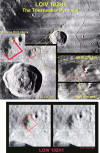 LOIV 102H1
shows a vertical view of the entire Sinus Medii region. LOIV 102H1
shows a vertical view of the entire Sinus Medii region.
Enough of the
‘pyramid’ was shown here for me to see that a greater part of
the northwest side of it was gone. After viewing this frame, I
wondered if I was indeed seeing a lunar ‘pyramid.’
However, from
looking at both oblique as well as the LO vertical view,
there is enough left of three distinct base lines to define its
undeniable pyramidal shape. I suspect that the missing portion
of this feature has either collapsed or has been hit and
destroyed by meteoric impact.
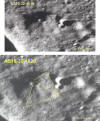 There is a
depression at the top of the pyramid suggesting that was
definitely destroyed by impact. There is a
depression at the top of the pyramid suggesting that was
definitely destroyed by impact.
I have found that
one discovery will lead to another if one is persistent. One of
the things that I have regularly done is to search the
surrounding lunar terrain when discovering a geometric signal.
Looking at close-ups of the terrain around the pyramid, I
discovered MORE geometry both on it as well as next to it.
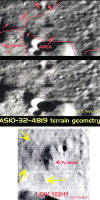 5 X 7” sectionals
of 4819 show an astounding array of rectilinear,
repetitive, and orthogonal structures just to the north side of
the pyramid. They extend out in an east-west orientation onto
Sinus Medii over a large area around Triesnecker. It
would be impossible to show them all here. These structures are
seen in better resolution on prints from the 4819 negative than
the 4820, although the same ones can still be discerned on 4820.
These structures seem to radiate out into the Bay
from this general location. 5 X 7” sectionals
of 4819 show an astounding array of rectilinear,
repetitive, and orthogonal structures just to the north side of
the pyramid. They extend out in an east-west orientation onto
Sinus Medii over a large area around Triesnecker. It
would be impossible to show them all here. These structures are
seen in better resolution on prints from the 4819 negative than
the 4820, although the same ones can still be discerned on 4820.
These structures seem to radiate out into the Bay
from this general location.
In addition to the
ones seen across and around the ‘pyramid’, they
are seen on the ‘pyramid.’ In my last posted piece,
The Hidden
Side - Part One,
I discussed the arches seen on the
flanks of far side Chaplygin crater.
 On the
Triesnecker Pyramid there is a monumental arch built
into the sunlit southeast side of the pyramid wall that looks
remarkably like the “Trajan Arch” pointed out at
Chaplygin
on frame AS10-29-4180. On the
Triesnecker Pyramid there is a monumental arch built
into the sunlit southeast side of the pyramid wall that looks
remarkably like the “Trajan Arch” pointed out at
Chaplygin
on frame AS10-29-4180.
Studying sectional photographs where these structures’ configurations
repeated themselves and how they fit into the terrain. It is obvious
that incessant meteoric rain has left them in a dilapidated state,
but enough of the incredible geometry is left intact to easily
distinguish them apart from the traditional geological model that
identify and interpret the area as, ‘hummocky material, swarms of
irresolvable secondary craters, ejecta fragments, and volcanic ash.”
(USGS, Mare Vaporum Quadrangle, Map I-548, LAC 59, Don E.
Wilhelms, 1968)
 Continuing to look
at the pyramid, I came across a small mound positioned next to it. Zooming into prints, I identified 4
equally spaced arch-like shadows. They look like
entryways or doors leading into the ‘mound’. They aren’t
difficult to see even on a 5 X 7” sectional. Continuing to look
at the pyramid, I came across a small mound positioned next to it. Zooming into prints, I identified 4
equally spaced arch-like shadows. They look like
entryways or doors leading into the ‘mound’. They aren’t
difficult to see even on a 5 X 7” sectional.
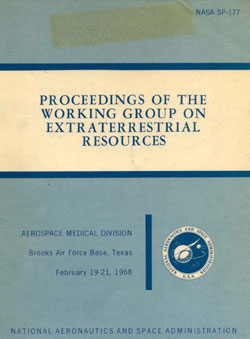 Upon seeing this
mound with ‘doors’, I sensed that I had seen this “picture”
somewhere before in my research. My mind recalled a 1968
NASA
study called the Proceedings of the Working Group on
Extraterrestrial Resources. It was compiled by technically
trained personnel from NASA, U.S. Air Force
and Navy,
U.S. Bureau of Mines, U.S. Geological Survey,
and the
Army Corps of Engineers. Upon seeing this
mound with ‘doors’, I sensed that I had seen this “picture”
somewhere before in my research. My mind recalled a 1968
NASA
study called the Proceedings of the Working Group on
Extraterrestrial Resources. It was compiled by technically
trained personnel from NASA, U.S. Air Force
and Navy,
U.S. Bureau of Mines, U.S. Geological Survey,
and the
Army Corps of Engineers.
In it, these Government agencies reflected their unanimous
active interest in the exploitation of space and space sciences,
including the Moon. In the chapter, Planning
Logic for Lunar Exploitation and Use, “mode alternatives”
and proposed lunar habitat systems are discussed. When I saw
this mound with the ‘doors’, I remembered a picture I’d seen in
that chapter that shows an artist’s conception of one of the
lunar habitat systems called, “System P”.

It is a picture of a
large semi-permanent base where authors speculated that the
lunar surface stay-times would accommodate 12 men for periods of
a year or more. The doors on the photograph of the mound look
remarkably like the entry-ways to the mounds at proposed
System P, however the Triesnecker mound doors
are larger and there are more than one.
If the spacing of the ‘doors’ in the mound at the Triesnecker
hadn’t have been so evenly spaced and lined up around the base, and
if the mound’s location hadn’t have been so unusually placed next to
a smaller crater, I wouldn’t have noticed it at all. Could it be
that a ‘System P’ has already been integrated into the
lunar landscape from a prior era’s lunar exploration? Can it be that
NASA has known this and that this is just another part of
their duplicitousness concerning what we know is there?
As the Triesnecker serendipity continued, another
recollection came to mind. Around the same time I was studying
studied the Triesnecker Pyramid, Hoagland wrote
a detailed paper concerning stunning artifacts seen on a frame of Clementine lunar mission data - a 1995 report called “Leak
of an Anomalous Clementine Multi -Spectral Mosaic -Frame APP172.JPG-
Preliminary Analysis Suggesting Ancient Lunar Artifacts”,
otherwise known as the ‘Clementine Paper’.
In it,
Hoagland states:
“During the 1994 DOD
(Department of Defense)
unmanned deep space mission, “Clementine”,
multi-spectral imaging returned by an on-board NIR (near- infrared)
camera, acquired stunning new evidence in support of a hypothesis
previously developed by this investigation and others: the presence of a vast array of ancient artificial structures on
the Moon.
This evidence (frame APP172JPG) after being
“leaked” to this investigation through the “Internet” is consistent
not only with an extensive array of highly deteriorated artificial
structures on the lunar surface – it also has revealed an
astonishingly deep extant to these geometric features, possibly
extending miles into the Moon.
This new evidence can also explain
the long-term puzzling historical lunar observations of the “dark,
lunar maria”, indicating that most – with the key exception of
Mare Imbrium – are now potentially the dark, exposed
foundations of formerly extensive lunar “cities” on the Moon.”
Detailed discussion on the
content of this extensive piece and of
the Clementine data in general is complex and too
detailed to discuss to any extent here. Suffice to say, the history
behind this frame and subsequent discovery regarding it has been
truly revelatory. Frame APP172.JPG was anonymously
“leaked” on the internet and after a few days, it mysteriously
disappeared. However it was downloaded and studied before this
happened. It revealed diverse and stunning redundant lunar geometry
of intelligent design in the area of Sinus Medii,
Hyginus Rille, and -- of Triesnecker crater.
When one sees the mosaic of APP172.JPG, it looks
different than an “ordinary” photograph. The colors represented on
APP172.JPG are in fact real colors due to the use of six
selective infrared filters in the on-board camera, but they were
downshifted to a region just beyond the red end of the visible
electromagnetic spectrum. Thus, the term, ‘near’ infrared (NIR).
It’s in the NIR spectrum that most solid materials
(like temperatures) interact with incoming electromagnetic
radiation, and to a sensor the intersection revealed what landscapes
and surfaces are made of.
 After Hoagland
had fitted the most obvious landmarks crater in APP172.JPG
to key features on a portion of the official Apollo 16
Lunar Photography Index map (such as Hyginus Rille
and
Triesnecker), it was determined that this frame
was a mosaic. The optical center of the frame is located about
10 degrees north. After Hoagland
had fitted the most obvious landmarks crater in APP172.JPG
to key features on a portion of the official Apollo 16
Lunar Photography Index map (such as Hyginus Rille
and
Triesnecker), it was determined that this frame
was a mosaic. The optical center of the frame is located about
10 degrees north.
Since the length and width of APP172.JPG is
significantly larger (562 by 522 miles), this mosaic has to
represent almost 300,000 sq. miles of lunar surface. So it is known
that about 500 individual Clementine NIR images were
composited together to produce APP172.JPG. The
Mars Mission (now Enterprise Mission) then
created an overlay identifying the geometric features seen in this
infrared image with key surface features photographed by visible
light cameras.
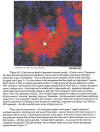  Looking closer, things
began to change. And on ultra-closeup sectionals, detailed geometric
structures around and over Triesnecker
become obvious.
(left photo: "click"
to enlarge) Looking closer, things
began to change. And on ultra-closeup sectionals, detailed geometric
structures around and over Triesnecker
become obvious.
(left photo: "click"
to enlarge)
But two other figures from
his paper really cinch the
Triesnecker geometry mentioned thus far on 4819
and 4820 (right photo: "click"
to enlarge)
 From looking at the
undeniable results seen on this
Clementine frame
along with the visible geometry seen on Hasselblad sectionals of
AS10-4819 and 4820, I believe that unequivocally, these data
corroborate each other with respect to artificiality in this
particular region of Central Bay on the Moon. What is
seen on 4819 and 20 specifically corroborates the east to west
orientation of the grid-like architecture seen on APP172.JPG. From looking at the
undeniable results seen on this
Clementine frame
along with the visible geometry seen on Hasselblad sectionals of
AS10-4819 and 4820, I believe that unequivocally, these data
corroborate each other with respect to artificiality in this
particular region of Central Bay on the Moon. What is
seen on 4819 and 20 specifically corroborates the east to west
orientation of the grid-like architecture seen on APP172.JPG.
In the Clementine Paper, Carl Sagan is quoted
saying:
“…at about 100 meter
resolution, everything changes. The planet is revealed to be covered
with straight lines, squares, rectangles, and circles…Their
regularity, complexity, and distribution would be hard to explain
except by life and intelligence…”
This description has been
used to describe the Earth alone. From the
APP172.JPG and Apollo data investigations at
Triesnecker (which corroborate each other), as well as
numerous other lunar studies done and reported on by this as well as
other investigations, this description can now be equally applied to
our sister planet. We have now found pyramids on the Moon,
and Mars.
Are they related to terrestrial pyramids? How
long has NASA really known about these and other
artifacts on these planets? The accumulated photographic evidence of
artificial structures extends back before Apollo ever went to the
Moon and --- even before the first Viking photographs were taken
of the Face on Mars.
As we all have said so many times, we have a ‘scientific crisis’ as
well as a problem concerning accountability. The Triesnecker
Pyramid
as well as the enigmatic geometrical artifacts around it are both
obvious and unique as far as their location. How can there be any
confusion surrounding NASA’s observations regarding
these photographs?
As Hoagland has said:
“The simplest explanation
for these myriad, redundant, and converging lunar observations,
acquired by a variety of imaging and other remote-sensing
technologies, both manned and unmanned….is becoming almost
inescapable: that what we apparently are seeing, are the surviving
remains of a former, widespread network of extensive ‘lunar
domes’ built by “someone” at many locations on the lunar
surface, at some significant removal from present time.”
Since the early 1990’s we
have found them, time and time again on the photographs that
NASA has taken.
Perhaps an open return to the Moon is the
only way to adequately address the many questions raised by our
findings. In the meantime, we feel it is a responsibility and duty
to continue to report on what the photographs tell us until the day
we do, or until the ones within NASA that know...
come clean.
|
 Early in
Richard
Hoagland’s lunar investigation, he discovered a ‘geometrically
square shape’ on Apollo 10 frame 4819
located very near Ukert crater in Sinus Medii.
From his years of grappling with the Cydonia geometry
trying to sift the signals from the noise of Martian
mesas and dunes, this rectilinear arrangement of hills and
parallel lines was a definitive anomalous lunar signal.
Early in
Richard
Hoagland’s lunar investigation, he discovered a ‘geometrically
square shape’ on Apollo 10 frame 4819
located very near Ukert crater in Sinus Medii.
From his years of grappling with the Cydonia geometry
trying to sift the signals from the noise of Martian
mesas and dunes, this rectilinear arrangement of hills and
parallel lines was a definitive anomalous lunar signal. 
 During Hoagland’s
subsequent visit to the NSSDC in Greenbelt, MD, he
not only asked archive director Dr. Joe King why there
was more than one version of 4822 when only one single frame was
listed as existing (a deliberate misrepresentation), but he also
presented assembled specific evidence supporting lunar artifacts
for this and other frames.
During Hoagland’s
subsequent visit to the NSSDC in Greenbelt, MD, he
not only asked archive director Dr. Joe King why there
was more than one version of 4822 when only one single frame was
listed as existing (a deliberate misrepresentation), but he also
presented assembled specific evidence supporting lunar artifacts
for this and other frames. 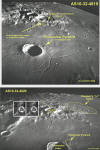






 Upon seeing this
mound with ‘doors’, I sensed that I had seen this “picture”
somewhere before in my research. My mind recalled a 1968
NASA
study called the Proceedings of the Working Group on
Extraterrestrial Resources. It was compiled by technically
trained personnel from NASA, U.S. Air Force
and Navy,
U.S. Bureau of Mines, U.S. Geological Survey,
and the
Army Corps of Engineers.
Upon seeing this
mound with ‘doors’, I sensed that I had seen this “picture”
somewhere before in my research. My mind recalled a 1968
NASA
study called the Proceedings of the Working Group on
Extraterrestrial Resources. It was compiled by technically
trained personnel from NASA, U.S. Air Force
and Navy,
U.S. Bureau of Mines, U.S. Geological Survey,
and the
Army Corps of Engineers. 



